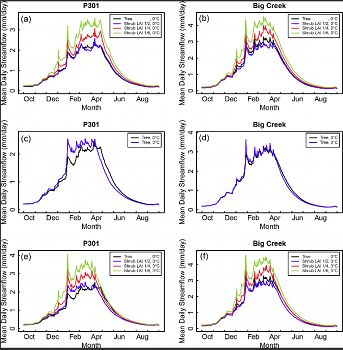Bart et al., 2016
Effect of Tree-to-Shrub Type Conversion in Lower Montane Forests of the Sierra Nevada (USA) on Streamflow
Bart, R. R.,Tague, C. L., Moritz, M. A. (2016)
PLOS ONE
-
Sierra, COLLABORATOR
-
Sierra, INVESTIGATOR
Abstract
Comparison of mean daily streamflow under historical conditions (100% forest and historical temperatures) and the following change scenarios; (a) & (b) 100% type conversion to shrubs with LAI 1/2, LAI 1/4 and LAI 1/6; (c) & (d) 3°C temperature increase, and (e) & (f) both type conversion and temperature increase.
Higher global temperatures and increased levels of disturbance are contributing to greater tree mortality in many forest ecosystems. These same drivers can also limit forest regeneration, leading to vegetation type conversion. For the Sierra Nevada of California, little is known about how type conversion may affect streamflow, a critical source of water supply for urban, agriculture and environmental purposes. In this paper, we examined the effects of tree-to-shrub type conversion, in combination with climate change, on streamflow in two lower montane forest watersheds in the Sierra Nevada. A spatially distributed ecohydrologic model was used to simulate changes in streamflow, evaporation, and transpiration following type conversion, with an explicit focus on the role of vegetation size and aspect. Model results indicated that streamflow may show negligible change or small decreases following type conversion when the difference between tree and shrub leaf areas is small, partly due to the higher stomatal conductivity and the deep rooting depth of shrubs. In contrast, streamflow may increase when post-conversion shrubs have a small leaf area relative to trees. Model estimates also suggested that vegetation change could have a greater impact on streamflow magnitude than the direct hydrologic impacts of increased temperatures. Temperature increases, however, may have a greater impact on streamflow timing. Tree-to-shrub type conversion increased streamflow only marginally during dry years (annual precipitation < 800 mm), with most streamflow change observed during wetter years. These modeling results underscore the importance of accounting for changes in vegetation communities to accurately characterize future hydrologic regimes for the Sierra Nevada.
Citation
Bart, R. R.,Tague, C. L., Moritz, M. A. (2016): Effect of Tree-to-Shrub Type Conversion in Lower Montane Forests of the Sierra Nevada (USA) on Streamflow. PLOS ONE . DOI: 10.1371/journal.pone.0161805
Explore Further



